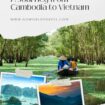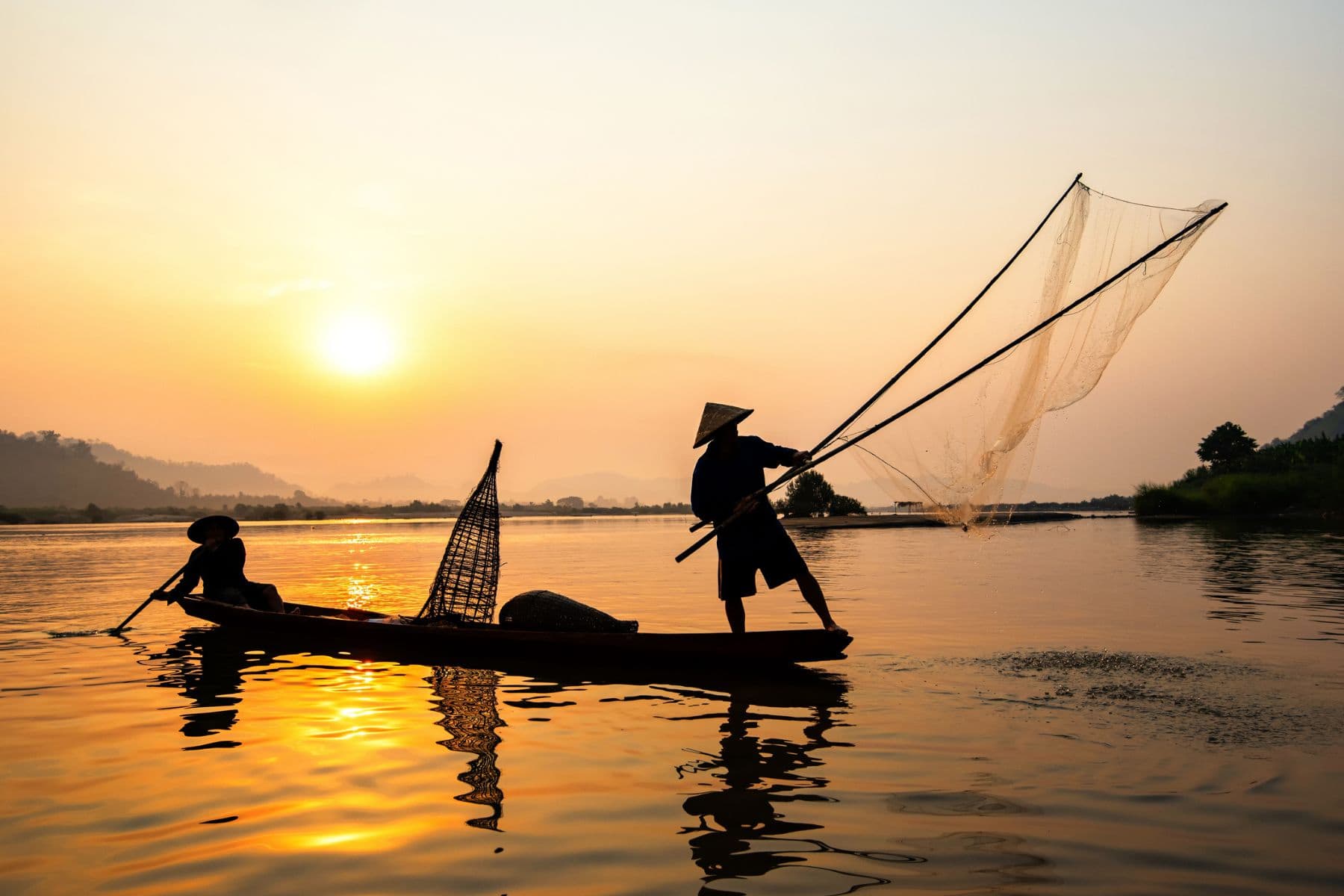
Go World Travel is reader-supported and may earn a commission from purchases made through links in this piece.
It’s mid-afternoon and the market in Sa Dec, Vietnam is bustling. Bubbling pools filled with live prawns, fish and eels line the walkways, while nearby, a vendor smiles shyly, showing me her catch of the day. Tidy bins loaded with cucumbers, garlic, lemons and coconuts stand ready for purchase, as a bike piled high with produce zips past, leaving the scent of lemongrass in the air.
The Sa Dec market on the banks of the Mekong is an important part of daily life here, and it’s a pleasure to wander its stalls. Our guide is 30-year-old AK, a Vietnamese guide with AmaWaterways. As he shares stories with our small group, it feels like sightseeing with a local friend.
Markets, Villages, & Farms Along the Mekong Delta
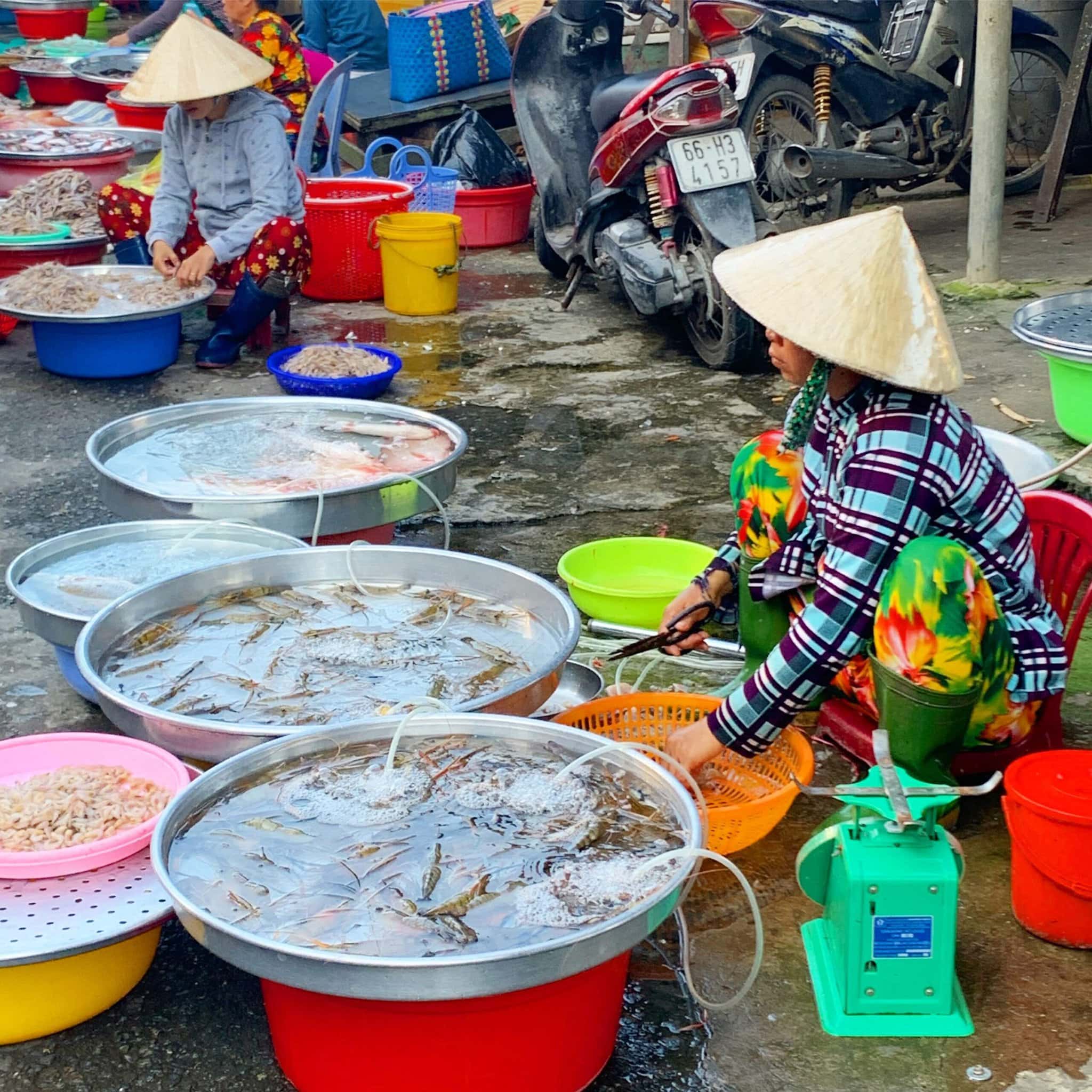
It’s just day two on our seven-day cruise with AmaWaterways, but already I’m glad we’ve come. For me, authentically experiencing a new culture is an important part of travel. AmaWaterways has already done that, introducing us to locals who share their arts, livelihoods and crafts. Excellent local guides, like AK, add insight to the experience.
Our market visit is just one adventure during our “Charms of the Mekong” river cruise with AmaWaterways. The cruise runs from Ho Chi Minh City in Vietnam (once known as Saigon) to Siem Reap, Cambodia, following the wide, slow-moving Mekong River.
Best Tips & Tools to Plan Your Trip
For centuries, the mighty Mekong has been a primary source of life in this fertile part of the world. It runs past villages, towns, temples and farmland. From the deck of the AmaDara, we have a front-row seat to it all.
We pass farmers with ox-driven carts working along the riverbanks, and fishermen in conical hats bringing in their nets. Floating villages gently move with the water, as barges give way to tiny Sampan boats on this gentle river highway.
Read More: Three Asian Countries to Add to Your Bucket List
Asia Cruise with AmaWaterways along the Mekong Delta
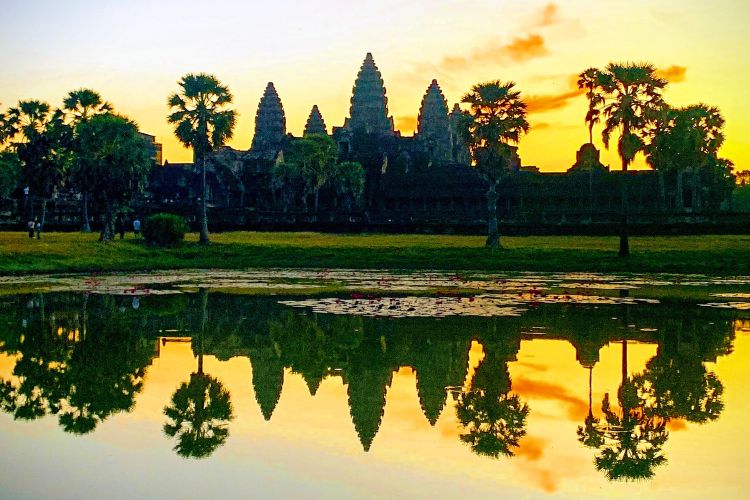
We had cruised with AmaWaterways in Europe and enjoyed their all-inclusive experience, so we were eager to see what they had to offer in Asia.
The AmaDara was built specifically for cruising the Mekong. The ship’s French-colonial design includes beautiful wood, from its floors to paneling to intricately carved room dividers.
Our stateroom is spacious for a cruise ship, with a French and outside balcony. One thing we like about river cruising is that you unpack once yet explore a different destination each day. While we plan to spend most of our time on excursions, or enjoying the ship, from its lovely Sun Deck to gym or comfortable lounge, we’ll sleep well on the AmaDara.
The pace onboard is relaxing, and the service is exemplary. We’re greeted by name each time we see the smiling staff, and soon come to feel very spoiled by the excellent food and careful service.
Dining on the AmaDara
Dining on the AmaDara is a highlight. The cuisine includes delicious local specialties, as well as classic Western favorites. Vietnamese and Cambodian cuisine uses fragrant herbs and spices, along with exotic fruits and vegetables. Fresh-caught fish is a daily highlight, along with different types of noodles and rice.
The Main Dining Room offers breakfast, lunch and dinner. You can also dine at The Chef’s Table, a small specialty restaurant where you can watch the chef prepare a daily tasting menu. AmaWaterways cruises are all-inclusive, so wine, house-brand spirits, local beer and soft drinks are complimentary throughout the cruise.
With only 124 passengers maximum, the AmaDara doesn’t feel crowded. The other passengers are a mix of ages and nationalities. We meet eight Canadian women on a girls’ getaway, a group of couples from Hawaii, and many others aged 25 to 80 who are eager to see Southeast Asia.
At first, we’re quiet around the other passengers, but as the days pass and we all share experiences, most of the passengers are as chatty as a school group. It’s just another benefit of river cruising.
Exploring Vietnam
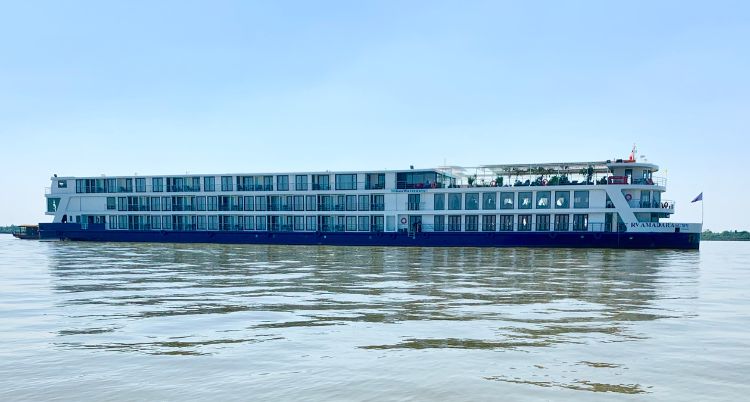
Vietnam is a land of contrasts. It’s undergone a fast-paced transition, yet we see timeless tradition alongside modern innovation. One afternoon, we stop at a family-owned rattan mat factory. A family member shows us how straw and silk threads are dyed by hand and then fed into large, noisy traditional looms.
Then we visit a rural farm on Evergreen island, where we meet an older farmer, a survivor of the Vietnam War. AK translates as the farmer welcomes us, then shares his story of life then – and now. Although I’m too young to remember the Vietnam war, many in our group, including several veterans, are deeply touched.
Exploring Cambodia
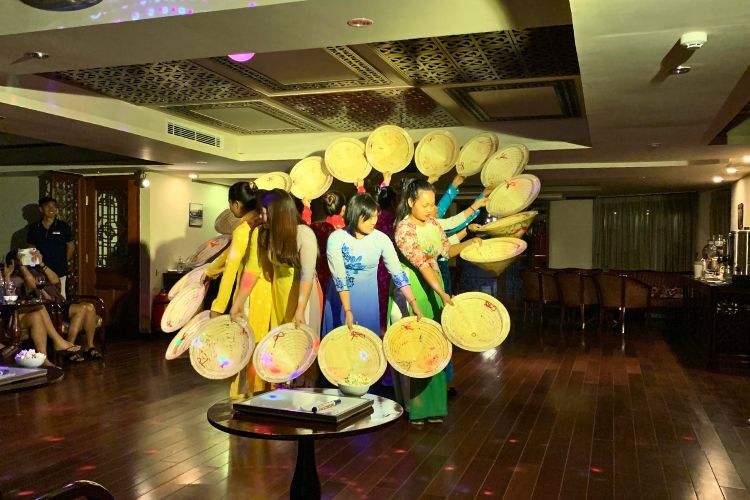
The next morning, we arrive in Cambodia. Once a mighty empire led by powerful kings (who built temples like Angkor Wat), Cambodia is a mostly agrarian society today. Their fertile farms produce rice, fruits and vegetables.
Though the country went through unimaginable war a generation ago, I’m touched by their resiliency. Cambodians have a well-earned reputation for being friendly and gentle — and I see this firsthand. We’re treated with kindness and a welcoming smile.
Our first Cambodian stop is Phnom Penh. This fast-growing city is home to 2 million of the country’s 15 million people. It’s a blend of traditional Khmer architecture, French Colonial influences and modern skyrises. The top landmark is the Royal Palace, which was built in 1866 for the Cambodian King. Today, it’s the official residence of King Norodom.
The gardens and several buildings are open to visitors. We spend the afternoon exploring it with our Cambodian guide, Pun. One of the most unusual sights there is the Silver Pagoda, which has five tons of shimmery silver covering the floor.
Back onboard that evening, we’re treated to a children’s dance troupe performing traditional Khmer folk dance. Dating back to the Angkorean era, traditional Apsara dancing is graceful and sophisticated.
A Buddhist Blessing
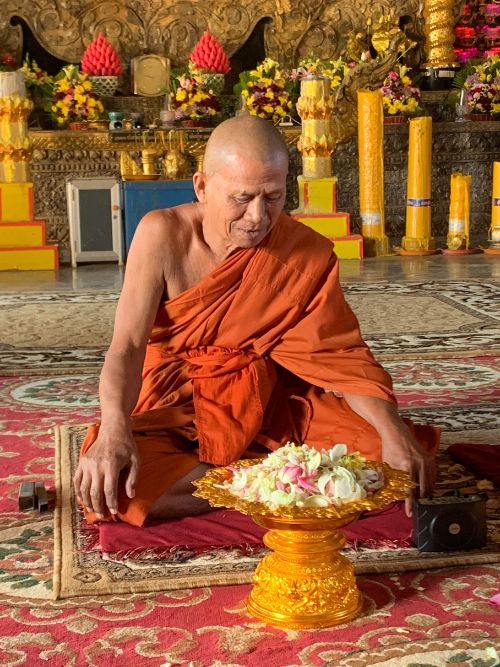
The next morning, we board a motor coach to visit Oudong, the former royal capital. These days, the city is a place of pilgrimage for Cambodians. Cambodia is a devout Buddhist country, and many come to visit Vipassana Dhura, the largest Buddhist monastery in Cambodia. It’s a highlight for travelers too.
Our Cambodian guide, Pun, once spent time as a monk. He gives us insight into the faith and the integral role it plays in daily life here. Then we are invited to receive a Buddhist blessing.
We take off our shoes before entering the temple, and then quietly sit before two monks. When we are ready, they chant a Buddhist blessing ceremony, tossing jasmine flowers. Although we can’t understand their words, we feel the intent. It’s a moving experience that we’ll remember.
AmaWaterways has tried to create excursions that are not only fun and enriching for guests but benefit the local communities as well. We experience one of those in Kampong Tralach. Oxen are still used in daily farm work in Cambodia. This small village has developed an agritourism experience for us – taking an oxcart tour through the village. It’s fun and unique, and we’re greeted by waving children along the way.
Tuk tuks are a main form of transportation in Cambodia. In the afternoon, we hop aboard one and tour the city of Phnom Penh, stopping at the legendary Buddhist temple of Wat Phnom. Tuk tuks are an efficient and safe way to get around. Rides are usually only a few dollars.
Silk Island on the Mekong Delta
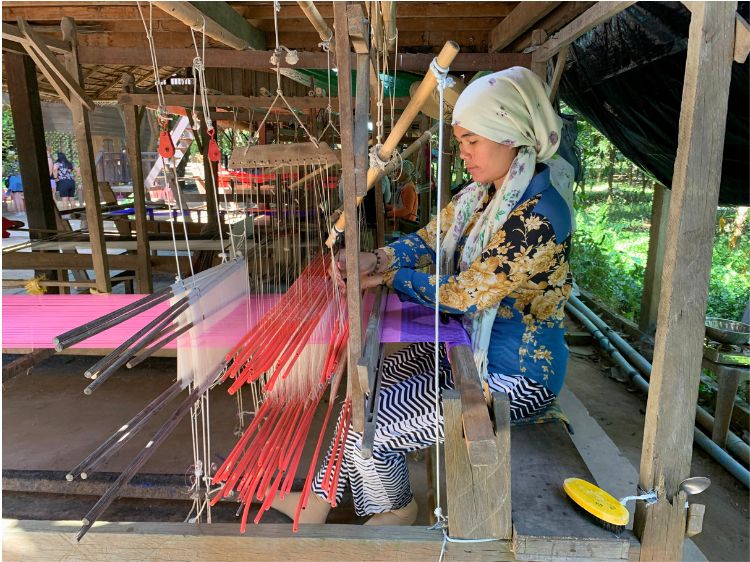
Just a few miles from Phnom Penh, but a world apart is our next destination — Oknhatey Village, also known as Silk Island. Cambodia has a rich silk-weaving heritage that stretches back to ancient times.
The lush island is home to many silk artisans. They raise silkworms and use tradition wooden looms to create beautiful silk scarves and clothing. After viewing the whole process, from silkworm to weaving to finished product, the silk scarves I purchase take on a deeper meaning.
Pun leads us on a walk through Oknhatey Village on the way back to our ship. He introduces us to several locals, who welcome us and share their stories (with Pun translating).
Then we stop in at a local school and visit an English class. The children ask us to teach them three new English words, which we do, and then sing them a song. They listen politely as we sing a weak rendition of “If You’re Happy and You Know It.”
Then we ask them to sing for us. They jump up happily and sing a rousing version of the same song, clapping with gusto. We have big grins on our faces when we continue through the village.
Angkor Wat
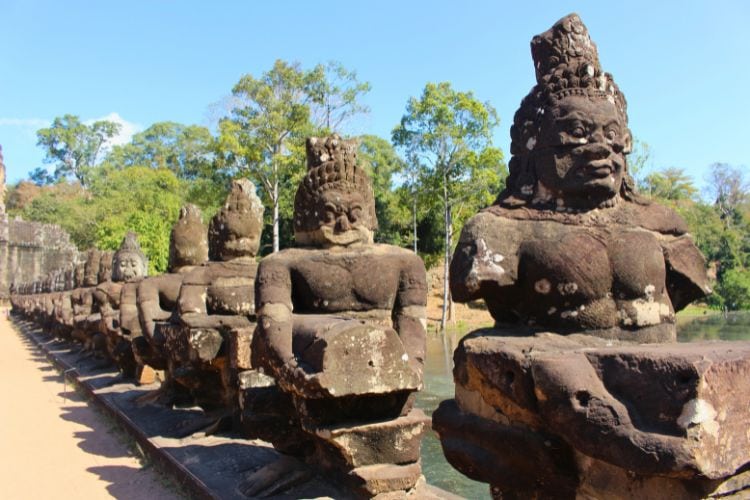
By the end of our river cruise, we’ve come to appreciate Cambodia in a new way. But that’s not the end of our journey.
The cruise line transports us from the ship to the city of Siem Reap, home to the famous Angkor Wat. Many passengers have booked three-day extensions with AmaWaterways. They’ll visit Angkor Wat and continue to Hanoi for an overnight cruise on Ha Long Bay.
As for Benjamin and me, we’re eager to explore Angkor Archeological Park on our own. Many believe that the best time to view the temple is at sunrise. So we rise at 4 am that next morning, and head to Angkor Wat.
We join others in the dark, waiting for first light. We’re looking forward to a full day ahead exploring the temples, from Angkor Wat to Bayon Temple to Ta Prohm.
But for now, we stand quietly and watch as the gentle gray skies turn into pink above Angkor Wat.
Read More: Beyond Angkor Wat: What to See & Do in Siem Reap, Cambodia
If You Go:
- Getting there: We flew from Denver to Tokyo then Ho Chi Minh City. On the return, we flew from Siem Reap to Ho Chi Minh to Tokyo to Denver. Book flights here.
- The US dollar is used in Vietnam and Cambodia, and many things are less expensive than in the USA. It’s best to bring small bills, including $1 bills, since change is only given in local currency.
- When visiting temples, shoulders and knees must be covered. No hats are worn in the temples.
- We recommend coming in a day ahead of your cruise. This gives you time to acclimate and provides leeway for any travel delays. We stayed at the lovely Sofitel Saigon Plaza in Ho Chi Minh and FCC Angkor in Siem Reap.
- Pre and post-cruise options: AmaWaterways offers a pre-cruise tour in Ho Chi Minh, and a three-day post-cruise tour to Angkor Wat, Banteay Srei and Angkor Thom, as well as a flight to Hanoi and overnight cruise in Ha Long Bay.
- Learn more about the AmaWaterways Mekong Delta Cruise
Read More:
- How to Plan a Family Vacation in the Outer Banks - April 5, 2024
- Top 5 Colorado Mountain Towns in Summer - March 22, 2024
- The Magic of the Mekong Delta: From Vietnam to Cambodia by River Cruise - March 6, 2024

